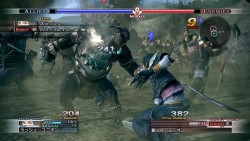Ever seen a film that just didn’t quite make it to perfect? Take the original three X-men films: they could have been amazing had they just made attempts at more subtle dialogue and more likeable characters. However, for their merits, these movies are still somewhat enjoyable. When a game has something wrong, a mechanic or an element that is annoying, it becomes nearly unplayable, and when that game had the potential to be an incredible experience, it’s nothing short of infuriating.
The Last Remnant is an RPG from developer Square Enix, the first they produced with Epic’s Unreal engine, and it had a lot going for it. On the surface it’s just a normal JRPG with a sub-standard story: the only difference is that there are more characters.
However, what makes this game incredible is a combination of dispelling classic art design combined with inspired game design, respectively muddied with a bad story and poor gameplay choices. One very impressive action the game takes is in the choice of the female lead, a character by the name of Emma Honeywell, replaced later by her daughter Emmy. This female protagonist, along with the main character’s sister, Irina, share an impressive progressivism in that they are not sexualized in the least. While Irina kind of looks like she’s going for a skip in the rain, Emma and Emmy both wear full armor that actually look reasonable to rush into battle with. While it does look a lot like a dress, it’s no more ridiculous than the technicolor dreamcoat worn by the second male lead, David Nassau.
This compliments the eponymous “Remnants,” old pieces of ancient technology from an age past, which are never expounded on. They remain mysterious the entire game and sit around, generally looking interesting. They take many many forms, and all of them are fascinating. The Schiavona takes the form of 3 swords, Tao Tie of two massive insects, Gwayn is a dragon and the Ubermarici are floating slivers of some unknown material. They give every town and area a personality, something to look at and characterize. They give a sense of grandeur and power behind the lords, beyond a natural authority.
In general the world is just fascinating: a congress making decisions alongside an immortal “God Emperor” who is respected and loved beyond belief by his people; a world where heaven literally exists above the capitol building; a world where a man with the ability to punch holes through his enemies and a strange connection to the protagonist travels freely. This game’s lore and backstory is absolutely fascinating, and it would make for one of the better JRPG stories if they actually gave us any information regarding anything. References by the antagonist, the “Conqueror,” about Rush, our male lead’s, awakening are never followed by any additional information. You are given the chance to fight the Conqueror; if you do, the game ends there, sans any expository dialogue about what just transpired. The game’s story is criminally underwritten.
But this is just half of what made this game reach so far and fall so flat. The next portion will have to wait until the next time, where we’ll discover the gameplay elements that could have made this game amazing, combined with the horribly backward design that makes a certain set of boss battles only a few inches away from impossible.


